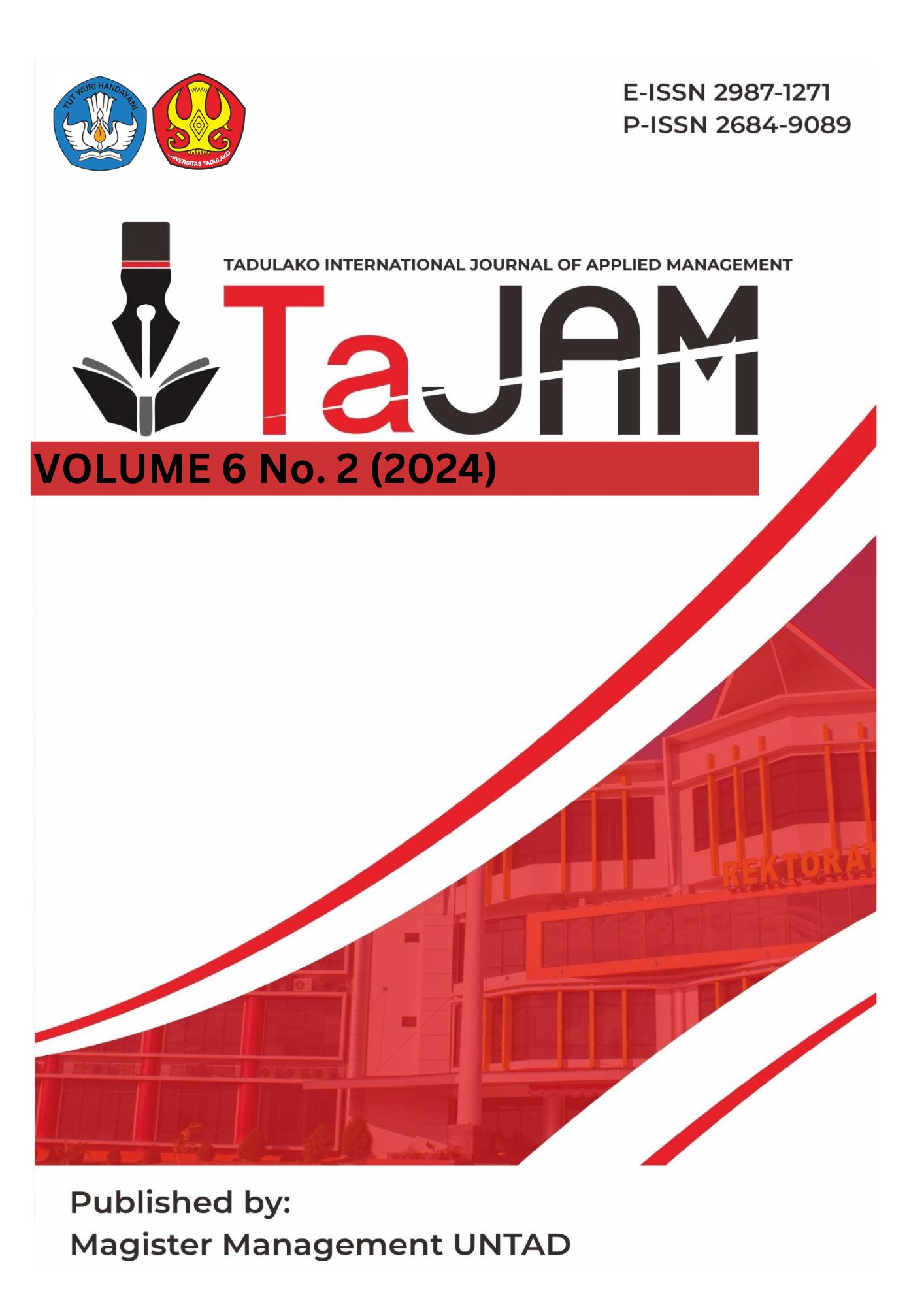THE EFFECT OF CONVENIENCE AND SECURITY OF USING QRIS PAYMENT METHODS ON PURCHASING DECISIONS WITH TRUST AS AN INTERVENING VARIABLE
DOI:
https://doi.org/10.59769/tajam.v6i2.138Keywords:
Convenience, security, Trust, Purchase Decision, Digital PaymentAbstract
This study aims to determine the effect of convenience and security of using digital payment methods (QRIS) on consumer purchasing decisions with trust as an intervening variable (the case of Generation Z purchases in Palu City). The type of research is quantitative. The research sample was Gen Z in Palu City which was determined through purposive sampling method and amounted to 100 people. This study uses the Structural Equation Modeling (SEM) method, which is operated with SMART-PLS. The results of this study indicate that 1) Ease of use of digital payment methods (QRIS) has a significant effect on purchasing decisions, 2) Security of using digital payment methods (QRIS) has a significant effect on purchasing decisions, 3) Ease of use of digital payment methods (QRIS) has a significant effect on trust, 4) Security of using digital payment methods (QRIS) has a significant effect on trust, 5) Trust has a significant effect on purchasing decisions, 6) Ease of use of digital payment methods (QRIS) has a significant effect on purchasing decisions, 7) The security of using digital payment methods (QRIS) has a significant effect on purchasing decisions.
References
Bangsa, J. R., & Khumaeroh, L. L. (2023). The Effect of Perceived Benefits and Ease of Use on the Decision to Use Shopeepay QRIS on Digital Business Students of Ngudi Waluyo University. Scientific Journal of Business, Management and Accounting, 3(1), 78-89.
Aditya, T., & Putu Mahyuni, L. (2002). The Influence of Financial Literacy, Perceived Convenience, Benefits, Security and Social Influence on Interest in Using Fintech. ournal of Economics, Management and Accounting, 4(3), 215-230.
Adnyana, & Purnami. (2016). The Influence of Entrepreneurship Education, Self-Efficacy and Locus of Control on Entrepreneurial Intentions. Unud Management E-Journal, 5(2), 112-125.
Anjani, D., Awali, H., & Misidawati, D. N. (2022). Analysis of Factors That Influence Generation Z's Interest in Using E-Wallet Payment Systems. Sahmiyya Journal, 1(1), 45-58.
Davis, F. D. (1989). Perceived Usefulness, Perceived Ease of Use, and User Acceptance of Information Technology. MIS Quarterly, 13(3), 319-340.
Arpaci, I., Kilicer, K., & Bardakci, S. (2015). Impact of Perceived Security on Organizational Adoption of Smartphones. Journal Cyberpsychology, Behavior, and Social Networking, 18(10), 602-608.
Dewi, L. K., & Suardika, I. M. (2021). Analysis of the Influence of Security, Convenience and Trust on Purchasing Decisions Through the Shopee Online Shopping Application With the Moderating Variable Word of Mouth (WOM). Journal of Economics & Sharia Economics, 4(2), 150-165.
Farokha, S., & Rivai, A. R. (2022). The Influence of Perceived Usefulness, Ease of Use, and Security on the Intention to Save on Pegadaian Gold Savings Products. Scientific Journal of Accounting and Finance, 5(4), 382-400.
Firmansyah, A. (2023). Development of Alternative B2C (Business to Customer) E-Payment Models. Jakarta: Rajawali Press.
Hartono, J. (2007). Behavioral Information Systems (Revised ed.). Yogyakarta: Andi.
Heidt, T., & Ponirin. (2011). Modeling the Complexity of E-Loyalty: The Role of E-Value, E-Trust, E-Satisfaction, and E-Commitment. Proceedings of the Australian and New Zealand Marketing Academy (ANZMAC) Conference, 1-9.
Hikmah, L. (2018). The Influence of Electronic Money on the Efficiency of the Transportation Payment System in the Jabotabek Area: Case Study of Students at UIN Syarif Hidayatullah Jakarta. Tesis, UIN Syarif Hidayatullah Jakarta.
Istiarni, D. (2014). Analysis of the Influence of Perceived Usefulness, Ease of Use and Credibility on Interest in Repeat Use of Internet Banking With Attitude of Use as an Intervening Variable. Journal of Business and Banking, 4(1), 1-14.
Jogiyanto, H. M. (2019). Behavioral Information Systems. Yogyakarta: Erlangga.
Kasiram, K. (2019). Research Methodology. Yogyakarta: Erlangga.
Kotler, P., & Keller, K. L. (2009). Marketing Management. Jakarta: Erlangga.
Kotler, P., & Keller, K. L. (2016). Marketing Management. Jakarta: PT. Index.
Mowen, J. C. (2011). Consumer Behavior (2nd ed.). Jakarta: Erlangga.
Primandari, I. D., & Suprapti, N. W. (2022). The Role of Trust Mediates the Effect of Perceived Ease of Use and Perceived Risk on Intention to Reuse QRIS Payment Methods. International Journal of Business, Economics & Management, 5(3), 201-210.
Rahmad, A. D., Astuti, E. S., & Riyadi. (2017). The Effect of Convenience on Trust and Use of SMS Banking. Journal of Business Administration, 43(1), 36-43.
Rumondang, A., Sudirman, A., Effendy, F., Simarmata, J., & Agustin, T. (2019). Fintech: Financial System Innovation in the Digital Era. Medan: Kita Write Foundation.
Sava, A. A., Mizoguchi, K. M., & Hardika, R. A. (2024). The Influence of Using the QRIS Payment Method on ITS Students' Purchasing Decisions: Case Study of the ITS Central Canteen. Journal of Information Systems and Computer Science, 2(1), 45-55.
Sugiyono. (2019). Quantitative and Qualitative Research and R&D Methodologies. Bandung: Alphabeta.
Sobandi, A., & Somantri, B. (2020). The Influence of Consumer Trust on Online Purchasing Decisions. IMWI Student Research Journal, 1(1), 12-20.
Syafitri, U. R., Maulana, A., & Rosa, A. (2024). The Influence of Trust and Convenience on Purchasing Decisions Using the Shopeepay Payment Method in Palembang City. Journal of Sharia Economics, Finance & Business, 6(4), 310-325.
Tjiptono, F. (2020). Marketing Strategy: Principles and Application. Yogyakarta: Andi.
Wulandari, F. D., & Ulya, H. N. (2023). The Influence of Promotions, Convenience and Benefits on the Decision to Use Shopeepay Transfers for FEBI IAIN Ponorogo Students. Baabu Al-Ilmi Journal, 8(1), 75-88.
Sutarman, M. A., Rombe, E., & Ponirin. (2024). The Effect of Product Quality and Qris Payment as a Moderating Variable on Repurchase Decision. Tadulako International Journal of Applied Management, 6(1).





